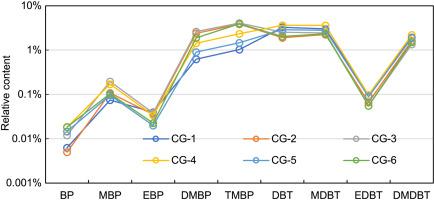The biomarker signatures in the Niujiaotang sulfide ore field: Exploring the role of organic matter in ore formation
IF 3.6
2区 地球科学
Q1 GEOSCIENCES, MULTIDISCIPLINARY
引用次数: 0
Abstract
The Niujiaotang Mississippi Valley-Type (MVT) Pb–Zn deposit (SW China) hosts 0.35 Mt Zn (5.85–24.48 wt%) and 5.3 kt Cd (0.04–1.43 wt%). Although previous inorganic geochemical studies have indicated a significant role of organic matter in mineralization, critical organic geochemical evidence is still lacking. This study presents the first integrated biomarker investigation of solid bitumen derived from the host rock of the deposit, clarifying the sources of organic matter, its thermal evolution, and metallogenic implications. Hydrothermal alteration assessments reveal that biomarker distributions have undergone only mild biodegradation and reliably preserved source and maturity information. Multiple maturity proxies indicate an over-mature stage (>150 °C), which meets the thermal requirement for thermochemical sulfate reduction (TSR). Saturated and aromatic hydrocarbon fingerprints, combined with carbon-isotope data, demonstrate derivation from Lower Cambrian source rocks dominated by marine algal/bacterial organic matter with minor terrestrial higher-plant input. The relative abundances of dibenzothiophene series compounds (5.84–9.54 %, mean 7.27 %) versus biphenyls (1.77–7.01 %, mean 4.62 %) provide robust molecular evidence for extensive TSR reactions. This study strengthens the interpretation that sulfur-rich hydrocarbons act as the principal reductant in TSR, facilitating the conversion of stratal sulfate to H2S and thereby establishing the reduced sulfur reservoir essential for Pb–Zn precipitation. Macroscopic intergrowths of solid bitumen with sulfide and carbonate gangue, alongside microscopic hydrocarbon inclusions in sphalerite and dolomite, corroborate this model. These organic-geochemical constraints refine genetic concepts for MVT deposits and emphasize the value of integrating petroleum system analysis into exploration workflows for analogous Pb–Zn systems.

牛角塘硫化物矿田生物标志特征:探讨有机质在成矿中的作用
牛角塘密西西比河谷型铅锌矿床(MVT)含锌0.35 Mt (5.85 ~ 24.48 wt%), Cd 5.3 kt (0.04 ~ 1.43 wt%)。尽管已有的无机地球化学研究表明有机质在成矿作用中起着重要作用,但仍缺乏重要的有机地球化学证据。本研究首次对该矿床主岩中固体沥青的生物标志物进行了综合研究,阐明了有机质来源、热演化及其成矿意义。热液蚀变评价表明,生物标志物的分布只经历了轻微的生物降解,并可靠地保存了来源和成熟度信息。多个成熟度指标表明其为过成熟阶段(>150°C),满足热化学硫酸盐还原(TSR)的热要求。饱和烃和芳烃指纹图谱结合碳同位素数据表明,下寒武统烃源岩以海生藻类/细菌有机质为主,陆生高等植物输入较少。二苯并噻吩系列化合物的相对丰度(5.84 - 9.54%,平均7.27%)与联苯的相对丰度(1.77 - 7.01%,平均4.62%)为广泛的TSR反应提供了强有力的分子证据。该研究强化了富硫烃在TSR中作为主要还原剂的解释,促进了地层硫酸盐向H2S的转化,从而建立了Pb-Zn沉淀所必需的还原硫储层。固体沥青与硫化物和碳酸盐脉石的宏观共生,以及闪锌矿和白云岩中的微观烃包裹体,证实了这一模型。这些有机地球化学约束完善了MVT矿床的成因概念,并强调了将石油系统分析整合到类似铅锌系统的勘探工作流程中的价值。
本文章由计算机程序翻译,如有差异,请以英文原文为准。
求助全文
约1分钟内获得全文
求助全文
来源期刊

Marine and Petroleum Geology
地学-地球科学综合
CiteScore
8.80
自引率
14.30%
发文量
475
审稿时长
63 days
期刊介绍:
Marine and Petroleum Geology is the pre-eminent international forum for the exchange of multidisciplinary concepts, interpretations and techniques for all concerned with marine and petroleum geology in industry, government and academia. Rapid bimonthly publication allows early communications of papers or short communications to the geoscience community.
Marine and Petroleum Geology is essential reading for geologists, geophysicists and explorationists in industry, government and academia working in the following areas: marine geology; basin analysis and evaluation; organic geochemistry; reserve/resource estimation; seismic stratigraphy; thermal models of basic evolution; sedimentary geology; continental margins; geophysical interpretation; structural geology/tectonics; formation evaluation techniques; well logging.
 求助内容:
求助内容: 应助结果提醒方式:
应助结果提醒方式:


